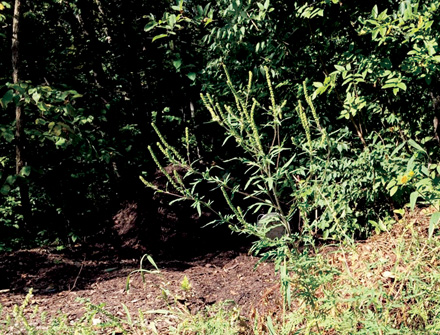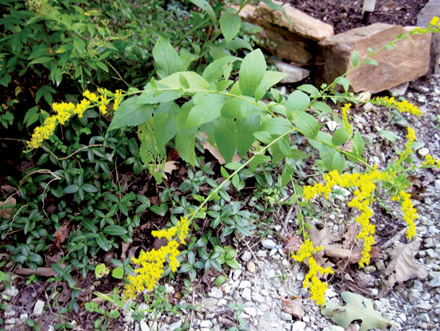What Makes Us Sneeze

Do you follow the daily pollen count reports? So do I but I will bet for different reasons.
You are following to know how aggravated your allergies may be. I keep an eye on pollen reports to know whether my bees will have food to take back to their colonies before they hunker down for winter.
In fall, pollen reports go up as the fall flow generates the last pollen hurrah. For beekeepers, it is also the last opportunity for bees to gather nectar to make honey for winter food. One of the plants beekeepers carefully watch is goldenrod. Goldenrod pollen can change the taste of honey so some beekeepers will harvest extra honey before goldenrod pollen gets stored and adds a bitter taste to the honey.
Missouri has more than 20 different goldenrod varieties, which is an herb. Some, such as Early goldenrod solidago juncea, bloom as early as June. Others, such as Showy goldenrod solidago speciosa, start in August and sometimes bloom through the first frost. Missouri even has a goldenrod variety named after the state, solidago missouriensis, The different varieties are hard to distinguish since they all tend to have similar, tiny daisy-like flowers in the same yellow color.
Nationwide, there are between 60 and 130 goldenrod varieties. According to old folklore, finding goldenrod near one’s house is a sign of good fortune.
One of the more interesting uses of goldenrod was as “Liberty tea.” After the 1773 Boston Tea Party, dried goldenrod was the only alternative for the banned, controversial tea often cited as the pivotal event that led to North America’s 1776 independence from England.
As a gardener interested in having low maintenance flowers, I have encouraged goldenrod to grow wherever it settled in my garden. They grow in very poor soil, require little care and add a pretty yellow color to our fall palette.
Goldenrods are often blamed for the high fall pollen count but they don’t deserve that reputation. The high fall pollen count is due to ragweed, an unassuming plant that grows at the same time as the various goldenrod varieties.
Ragweed is a drab, aster cousin. It’s Latin name, Ambrosia, means “food of the Gods,” which must have a reason but I haven’t been able to find it yet. Although not very showy, these plants are important to restore soil. Ragweed is the first plant to move into disturbed, barren areas. The plant produces nutrients that enrich soil enough so that other species with different ecological requirements can move in.
Ragweed basically self-destructs. As they grow, roots die as new ones develop. Decaying roots release a toxin that is harmful only to ragweed. When toxin levels are high enough, the soil no longer supports ragweed so it dies, making room for new plant species.
Ragweed is distributed throughout North America. It is pollinated by wind, which explains how one plant can produce about a billion grains of pollen per season. It causes about half of all cases of pollen-associated allergic reactions in North America, starting in July through first frost.
Charlotte Ekker Wiggins is a certified gardener, beekeeper and sometimes cook. Copyright 2016 used with permission, all rights reserved. This material may not be published, broadcast, rewritten or redistributed. Contact Charlotte at chargardens@gmail.com.

RAGWEED HAS A PURPOSE – Unassuming ragweed is responsible for most fall sneezing, a plant that has a short life as it helps to restore disturbed and barren soil areas. (Photos by Charlotte Ekker Wiggins).

JUST PRETTY, NO PROBLEM – Showy goldenrod, an herb, is often mistaken as the cause of allergic reactions to fall pollen.



Facebook Comments